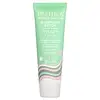What's inside
What's inside
 Key Ingredients
Key Ingredients

 Benefits
Benefits

 Concerns
Concerns

 Ingredients Side-by-side
Ingredients Side-by-side

Sea Salt
AbrasiveSodium Chloride
MaskingRosmarinus Officinalis Leaf Extract
AntimicrobialWater
Skin ConditioningPinus Densiflora Leaf Extract
AntimicrobialSodium Methyl Cocoyl Taurate
CleansingGlycerin
HumectantCoco-Betaine
CleansingLauryl Betaine
CleansingZingiber Officinale Root Extract
MaskingXanthan Gum
EmulsifyingPropanediol
SolventEthylhexylglycerin
Skin ConditioningRosmarinus Officinalis Leaf Oil
MaskingOcimum Basilicum Leaf Extract
Skin ConditioningOcimum Sanctum Leaf Extract
Skin ConditioningOriganum Vulgare Leaf Extract
Skin ConditioningBifida Ferment Lysate
Skin ConditioningLactobacillus Ferment Lysate
Skin ConditioningCaffeine
Skin ConditioningPanthenol
Skin ConditioningMoringa Oleifera Seed Oil
EmollientMenthol
MaskingSalicylic Acid
MaskingCedrus Atlantica Bark Oil
MaskingAbies Sibirica Oil
MaskingCupressus Sempervirens Oil
MaskingNiacinamide
SmoothingChamomilla Recutita Flower Extract
MaskingVerbena Officinalis Extract
EmollientStyrax Benzoin Resin Extract
MaskingDipropylene Glycol
HumectantLimonene
PerfumingGuar Hydroxypropyltrimonium Chloride
Skin ConditioningMelia Azadirachta Leaf Extract
Skin ConditioningMelia Azadirachta Flower Extract
Skin ConditioningCoccinia Indica Fruit Extract
Skin ConditioningAmber Powder
Solanum Melongena Fruit Extract
Skin ConditioningCurcuma Longa Root Extract
MaskingCorallina Officinalis Extract
Skin ConditioningDisodium EDTA
1,2-Hexanediol
Skin ConditioningSea Salt, Sodium Chloride, Rosmarinus Officinalis Leaf Extract, Water, Pinus Densiflora Leaf Extract, Sodium Methyl Cocoyl Taurate, Glycerin, Coco-Betaine, Lauryl Betaine, Zingiber Officinale Root Extract, Xanthan Gum, Propanediol, Ethylhexylglycerin, Rosmarinus Officinalis Leaf Oil, Ocimum Basilicum Leaf Extract, Ocimum Sanctum Leaf Extract, Origanum Vulgare Leaf Extract, Bifida Ferment Lysate, Lactobacillus Ferment Lysate, Caffeine, Panthenol, Moringa Oleifera Seed Oil, Menthol, Salicylic Acid, Cedrus Atlantica Bark Oil, Abies Sibirica Oil, Cupressus Sempervirens Oil, Niacinamide, Chamomilla Recutita Flower Extract, Verbena Officinalis Extract, Styrax Benzoin Resin Extract, Dipropylene Glycol, Limonene, Guar Hydroxypropyltrimonium Chloride, Melia Azadirachta Leaf Extract, Melia Azadirachta Flower Extract, Coccinia Indica Fruit Extract, Amber Powder, Solanum Melongena Fruit Extract, Curcuma Longa Root Extract, Corallina Officinalis Extract, Disodium EDTA, 1,2-Hexanediol
Sea Salt
AbrasiveCocamidopropyl Hydroxysultaine
CleansingGlycerin
HumectantSucrose
HumectantGlyceryl Caprylate/Caprate
EmollientSodium Methyl Cocoyl Taurate
CleansingSodium Cocoyl Isethionate
CleansingJojoba Esters
EmollientCharcoal Powder
AbrasiveRosmarinus Officinalis Leaf Extract
AntimicrobialLavandula Angustifolia Flower Extract
CleansingRosa Moschata Seed Oil
EmollientMentha Piperita Oil
MaskingMenthol
MaskingMelaleuca Alternifolia Leaf Oil
AntioxidantGlyceryl Stearate Se
EmulsifyingLactococcus Ferment Lysate
Skin ConditioningOryza Sativa Bran Extract
Skin ConditioningHelianthus Annuus Extract
EmollientTocopherol
AntioxidantSodium Benzoate
MaskingPotassium Sorbate
PreservativeSodium Gluconate
Skin ConditioningIron Oxides
Citric Acid
BufferingParfum
MaskingSea Salt, Cocamidopropyl Hydroxysultaine, Glycerin, Sucrose, Glyceryl Caprylate/Caprate, Sodium Methyl Cocoyl Taurate, Sodium Cocoyl Isethionate, Jojoba Esters, Charcoal Powder, Rosmarinus Officinalis Leaf Extract, Lavandula Angustifolia Flower Extract, Rosa Moschata Seed Oil, Mentha Piperita Oil, Menthol, Melaleuca Alternifolia Leaf Oil, Glyceryl Stearate Se, Lactococcus Ferment Lysate, Oryza Sativa Bran Extract, Helianthus Annuus Extract, Tocopherol, Sodium Benzoate, Potassium Sorbate, Sodium Gluconate, Iron Oxides, Citric Acid, Parfum
Ingredients Explained
These ingredients are found in both products.
Ingredients higher up in an ingredient list are typically present in a larger amount.
Glycerin is already naturally found in your skin. It helps moisturize and protect your skin.
A study from 2016 found glycerin to be more effective as a humectant than AHAs and hyaluronic acid.
As a humectant, it helps the skin stay hydrated by pulling moisture to your skin. The low molecular weight of glycerin allows it to pull moisture into the deeper layers of your skin.
Hydrated skin improves your skin barrier; Your skin barrier helps protect against irritants and bacteria.
Glycerin has also been found to have antimicrobial and antiviral properties. Due to these properties, glycerin is often used in wound and burn treatments.
In cosmetics, glycerin is usually derived from plants such as soybean or palm. However, it can also be sourced from animals, such as tallow or animal fat.
This ingredient is organic, colorless, odorless, and non-toxic.
Glycerin is the name for this ingredient in American English. British English uses Glycerol/Glycerine.
Learn more about GlycerinMenthol is a compound found in mint plants, such as peppermint. In its pure form, it is a clear crystalline substance.
Menthol is known for its cooling sensation; however, the cooling is actually from your skin being sensitized. Menthol can worsen rosacea. We recommend speaking with a professional if you have concerns.
Menthol also has antimicrobial properties.
Learn more about MentholRosmarinus Officinalis Leaf Extract comes from rosemary. Rosemary is native to the Mediterranean.
While Rosmarinus Officinalis Leaf Oil can be volatile due to its fragrant properties, the fragrance components are usually removed in the leaf extract.
Rosemary Leaf Extract contains many antioxidants such as rosmarinic acid and caffeic acid. Rosemarinic acid, a compound found in rosemary leaf, has been found to help soothe skin conditions such as eczema and acne.
Learn more about Rosmarinus Officinalis Leaf ExtractSea salt has abrasive or exfoliation properties. It can sensitize and dry out the skin.
This gentle cleansing and foaming ingredient is known for leaving a smooth feeling in skin and hair. It is made using coconut oil.
According to the manufacturer, it is soluble in water and has resistance to hard water, acid, and alkali.
Due to its coconut base, it may not be Malassezia folliculitis safe.
Learn more about Sodium Methyl Cocoyl Taurate